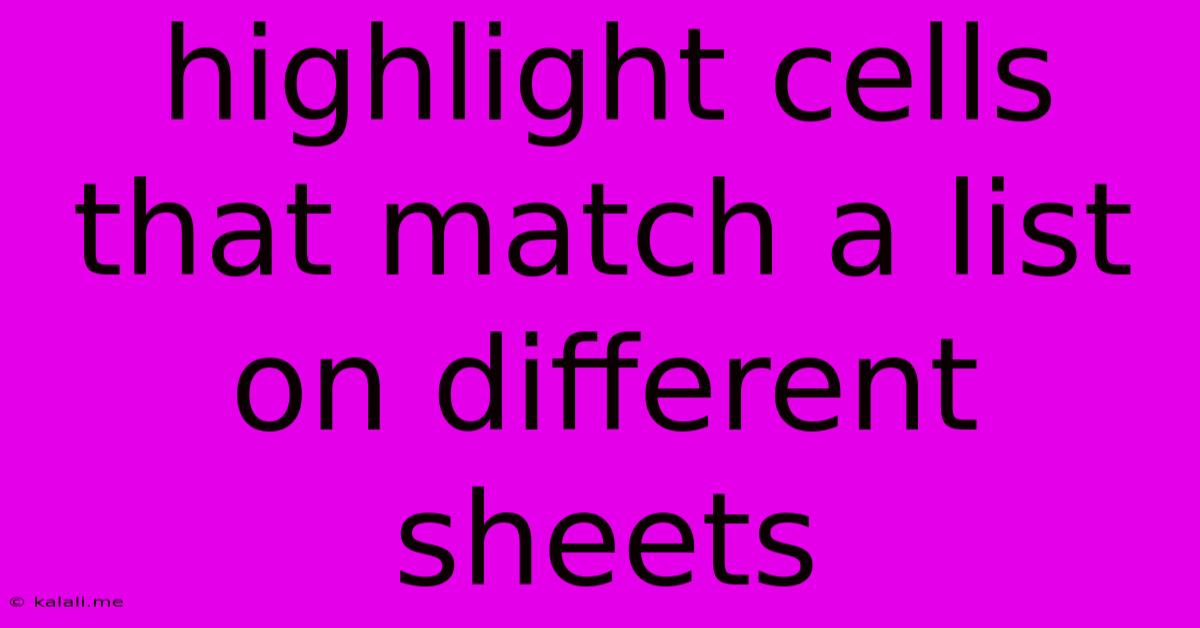Highlight Cells That Match A List On Different Sheets
Kalali
Jun 08, 2025 · 3 min read

Table of Contents
Highlight Cells That Match a List on Different Sheets: A Comprehensive Guide
This guide will walk you through various methods to highlight cells in one Excel sheet that match a list of values found on a different sheet. This is a common task in data analysis and reporting, simplifying the process of identifying matching entries across multiple datasets. Whether you're working with small or large datasets, these techniques will streamline your workflow. We'll explore both manual and automated approaches, leveraging Excel's built-in features and formulas.
Understanding the Problem:
You have two (or more) Excel sheets. One sheet contains a list of values (your "reference list"), and another sheet contains a dataset where you want to highlight cells that match values from your reference list. The challenge lies in efficiently identifying these matches and visually highlighting them.
Method 1: Using Conditional Formatting with MATCH
This method is ideal for smaller datasets and offers a visually appealing solution. Conditional formatting allows you to automatically highlight cells based on specified criteria.
-
Prepare your data: Ensure your reference list is on a separate sheet (let's call it "Sheet2," with the list in column A). The data you want to highlight is on "Sheet1."
-
Select the range to highlight: On "Sheet1," select the entire range of cells you want to check for matches.
-
Apply Conditional Formatting: Go to Home -> Conditional Formatting -> New Rule.
-
Choose a rule type: Select "Use a formula to determine which cells to format."
-
Enter the formula: In the formula bar, enter the following formula (adjusting cell references as needed):
=ISNUMBER(MATCH(A1,Sheet2!$A$1:$A$100,0))A1: This refers to the top-left cell of your selected range on "Sheet1". It will automatically adjust as you apply the formatting.Sheet2!$A$1:$A$100: This is the absolute reference to your reference list on "Sheet2". Adjust$A$100to the last row of your list.0: This ensures an exact match is required.
-
Choose formatting: Click "Format," choose the desired formatting (e.g., fill color), and click "OK" twice.
Method 2: Using Conditional Formatting with COUNTIF
COUNTIF offers a more straightforward approach for highlighting matches.
-
Follow steps 1-3 from Method 1.
-
Enter the formula: Use this formula in the "New Rule" dialog:
=COUNTIF(Sheet2!$A$1:$A$100,A1)>0This formula counts how many times the value in
A1(on "Sheet1") appears in your reference list on "Sheet2". If the count is greater than 0, the cell is highlighted.
Method 3: VBA Macro for Automation (Advanced)
For larger datasets or frequent use, a VBA macro provides a more automated solution. This requires some basic VBA knowledge.
Sub HighlightMatchingCells()
Dim wsData As Worksheet, wsRef As Worksheet
Dim lastRowData As Long, lastRowRef As Long
Dim i As Long, j As Long
Set wsData = ThisWorkbook.Sheets("Sheet1") 'Change "Sheet1" if needed
Set wsRef = ThisWorkbook.Sheets("Sheet2") 'Change "Sheet2" if needed
lastRowData = wsData.Cells(Rows.Count, "A").End(xlUp).Row 'Assumes data in column A
lastRowRef = wsRef.Cells(Rows.Count, "A").End(xlUp).Row 'Assumes reference list in column A
For i = 1 To lastRowData
For j = 1 To lastRowRef
If wsData.Cells(i, "A").Value = wsRef.Cells(j, "A").Value Then
wsData.Cells(i, "A").Interior.Color = vbYellow 'Change color as needed
Exit For 'Exit inner loop once a match is found
End If
Next j
Next i
End Sub
This macro iterates through the data and reference lists, highlighting matching cells. Remember to adjust sheet names and column references as needed.
Choosing the Right Method:
- Method 1 & 2 (Conditional Formatting): Best for smaller datasets, ease of use, and visual appeal. Offers good performance even with moderately large datasets.
- Method 3 (VBA Macro): Best for very large datasets, automation needs, and situations where you frequently perform this task. Requires VBA knowledge.
Remember to always back up your data before implementing any of these methods. By understanding these techniques, you can effectively highlight cells that match a list across different Excel sheets, improving your data analysis and reporting efficiency.
Latest Posts
Latest Posts
-
What Is Bigger Than A Universe
Jun 08, 2025
-
What Are The Vials In Fallout
Jun 08, 2025
-
How Long Is Sangria Good For
Jun 08, 2025
-
How To Get Small Dent Out Of Car
Jun 08, 2025
-
Can You Breed Ditto With Ditto
Jun 08, 2025
Related Post
Thank you for visiting our website which covers about Highlight Cells That Match A List On Different Sheets . We hope the information provided has been useful to you. Feel free to contact us if you have any questions or need further assistance. See you next time and don't miss to bookmark.